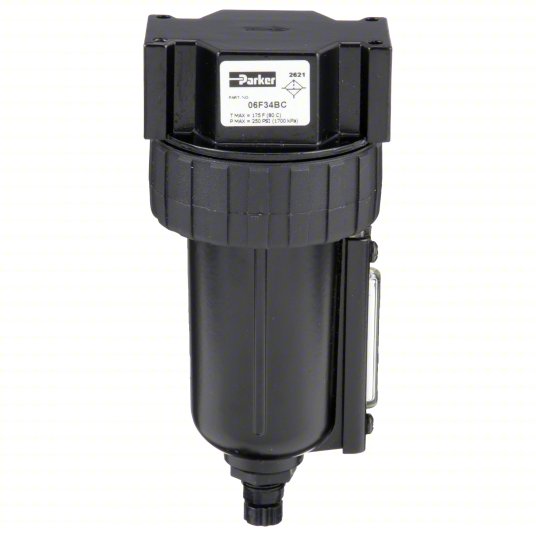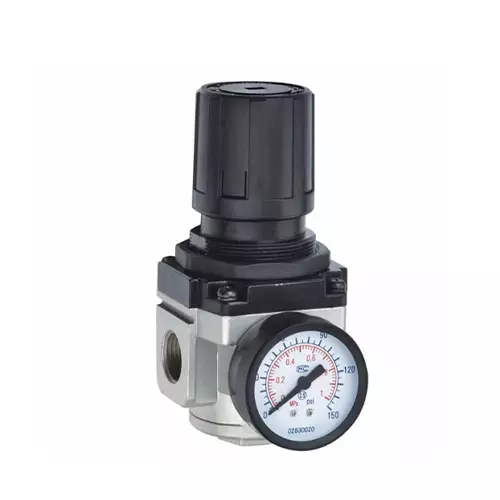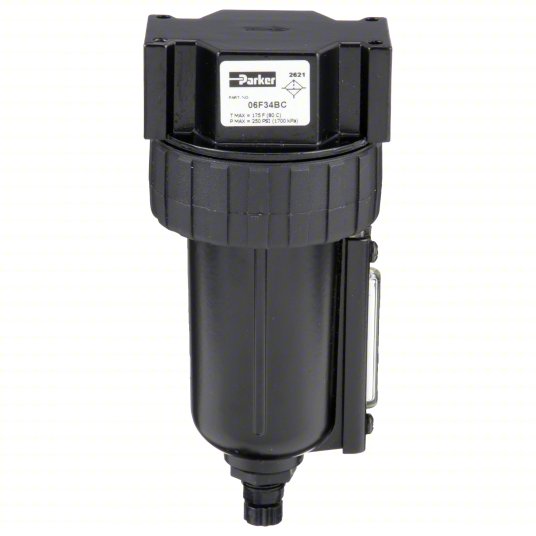Contact : +91-79045 61980 | Email: hydrofitengineers@gmail.com
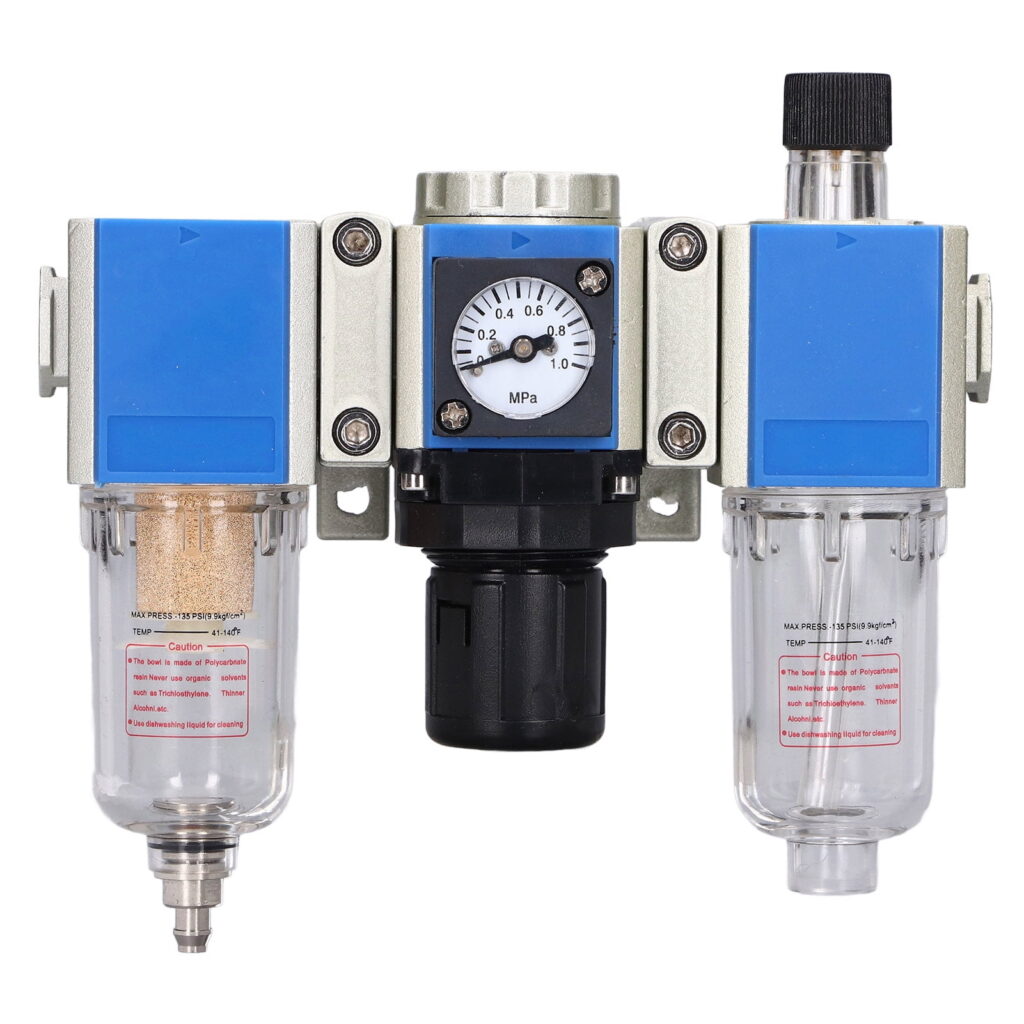
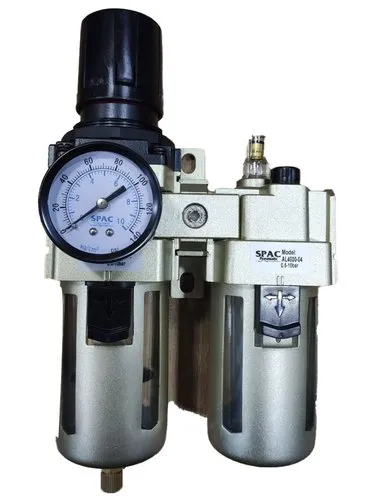
PNEUMATIC AIR FILTER REGULATOR UNITS (FRL Units)
Pneumatic air filter regulators and lubricators (FRLs) are essential components of a pneumatic system. They play a vital role in ensuring that the compressed air used in pneumatic systems is clean, dry, and lubricated, which is critical for the proper operation of pneumatic actuators such as cylinders and motors
Pneumatic air filter regulator lubricators, commonly known as FRL units, are essential components in pneumatic systems. Here’s a breakdown of each component’s function :
Compressed air used in pneumatic systems is often contaminated with dust, moisture, and oil. These contaminants can cause significant damage to pneumatic actuators, resulting in poor performance and decreased lifespan. Pneumatic FRLs are designed to remove these contaminants from the compressed air before it enters the pneumatic system, ensuring that the system operates smoothly and efficiently.
- Filter: The filter removes contaminants like dust, dirt, oil, and water droplets from the compressed air, ensuring cleaner air flows through the system. It typically consists of a porous material that traps particles as air passes through.
- Regulator: The regulator controls the pressure of the compressed air flowing through the system. It maintains a steady, predetermined pressure level regardless of fluctuations in the input pressure. This is crucial for ensuring consistent performance of pneumatic tools and equipment.
- Lubricator: The lubricator adds a controlled amount of lubricating oil to the compressed air stream. This helps lubricate pneumatic components such as cylinders, valves, and air motors, reducing friction and wear, and prolonging their lifespan.
These three components are often combined into a single unit for convenience and efficiency. FRL units come in various sizes and configurations to suit different pneumatic system requirements. Proper installation and maintenance of FRL units are essential to ensure optimal performance and longevity of pneumatic systems
Functions of Pneumatic Air Filter Regulator Lubricators (FRL Units)
- Filtering: The filter component removes contaminants such as dust, dirt, oil, and water vapor from the compressed air stream. This ensures that the air entering the pneumatic system is clean, preventing damage to sensitive pneumatic components and ensuring reliable operation.
- Regulating: The regulator component controls the pressure of the compressed air within the system. By setting a desired pressure level, the regulator ensures that pneumatic tools and equipment receive consistent and optimal air pressure for their operation. It also protects downstream components from damage due to excessive pressure.
- Lubricating: The lubricator component adds a fine mist of lubricating oil to the compressed air stream. This lubricates moving parts within pneumatic tools and equipment, reducing friction, wear, and corrosion. Proper lubrication helps maintain the performance and longevity of pneumatic components.
- Maintaining System Efficiency: By providing clean, regulated, and lubricated air, FRL units help maintain the efficiency and reliability of pneumatic systems. Clean air prevents blockages and damage to components, while regulated pressure ensures consistent performance. Lubrication reduces wear and tear, minimizing maintenance requirements and downtime.
- Protecting Equipment: FRL units protect pneumatic tools and equipment from damage caused by contaminants and fluctuating air pressure. This helps extend the lifespan of pneumatic components and reduces the need for costly repairs or replacements.
Improving Air Quality: By removing contaminants from the compressed air, FRL units contribute to improved air quality within the working environment. This is particularly important in applications where clean air is essential, such as in food processing or pharmaceutical manufacturing
Overall, FRL units play a vital role in ensuring the efficiency, reliability, and longevity of pneumatic systems by providing clean, regulated, and lubricated air to pneumatic tools and equipment
Pneumatic Air Filters
Pneumatic air filters are designed to remove contaminants from compressed air, ensuring that only clean air flows through the system. These contaminants can include dust, dirt, oil, water vapor, and other particulate matter. By removing these impurities, air filters prevent damage to sensitive pneumatic components such as valves, cylinders, and actuators.
Types Of Pneumatic Air Filters
- Particulate Filters: Particulate filters are the most common type of pneumatic air filters. They utilize a porous filtering material, such as paper or synthetic fibers, to trap solid particles from the compressed air stream. These filters are effective at removing dust, dirt, and other solid contaminants.
- Coalescing Filters: Coalescing filters are specialized filters designed to remove liquid contaminants, such as oil and water, from the compressed air. They use a unique filtration mechanism to capture tiny droplets of liquid and coalesce them into larger droplets that can be drained away. Coalescing filters are essential for applications where clean, dry air is critical, such as in precision manufacturing or laboratory settings.
- Activated Carbon Filters: Activated carbon filters are used to remove odors, vapors, and other gaseous contaminants from the compressed air. These filters contain activated carbon, which has a high surface area and adsorptive properties. As air passes through the filter, odorous or harmful gases are trapped by the activated carbon, resulting in cleaner air.
- Combination Filters: Combination filters combine multiple filtration mechanisms into a single unit, offering comprehensive protection against various types of contaminants. These filters typically integrate particulate, coalescing, and activated carbon filtration stages to provide high-quality compressed air.
Importance of Pneumatic Air Filters
Compressed air used in pneumatic systems is often contaminated with dust, moisture, and oil. These contaminants can cause significant damage to pneumatic actuators, resulting in poor performance and decreased lifespan. Pneumatic FRLs are designed to remove these contaminants from the compressed air before it enters the pneumatic system, ensuring that the system operates smoothly and efficiently.
- Protection of Pneumatic Components: Pneumatic air filters safeguard sensitive pneumatic components from damage caused by contaminants. By ensuring clean air supply, filters prevent clogging, wear, and malfunction of valves, cylinders, and other components.
- Improved System Reliability: Clean air provided by pneumatic filters enhances the reliability and efficiency of pneumatic systems. Consistent air quality prevents unexpected downtime and costly repairs, resulting in increased productivity and profitability.
- Enhanced Product Quality: In applications where air quality directly affects product quality, such as in food processing or pharmaceutical manufacturing, pneumatic air filters play a crucial role. By removing contaminants, filters help maintain product integrity and meet quality standards.
Worker Safety: Clean air is essential for ensuring a safe working environment for personnel. Pneumatic air filters help reduce exposure to harmful contaminants and airborne particles, protecting the health and well-being of workers
TECHNO JELPC SPAC JANATICS FESTO

